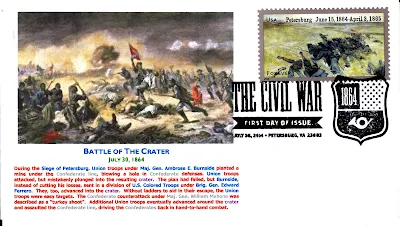USPS on 30 July 2014 issued the fourth installment satisfy the .49 cent Civil War Sesquicentennial stamps. Cancellation postmark originated from Petersburg, Virginia and Mobile, Alabama, the site of two battles. Banknote Corporation of America for Sennett Security Products printed a total of 10,800,000 self-adhesive stamps, using a lithograph in double-sided sheets of 72 with six panes of 12 per sheet.
These stamps commemorated the 150th anniversary of the Civil War. They picture the 22nd United States Colored Troops at the Battle of Petersburg and Admiral Farragut’s fleet during the Battle of Mobile Bay.
Following his successful siege of Vicksburg and victory at Chattanooga the previous year, Ulysses S. Grant was promoted to general-in-chief of the Union Army in March 1864. In the months that followed, Grant began persistent campaigns against the under-resourced Confederacy.
Following his successful siege of Vicksburg and victory at Chattanooga the previous year, Ulysses S. Grant was promoted to general-in-chief of the Union Army in March 1864. In the months that followed, Grant began persistent campaigns against the under-resourced Confederacy.
The Union was poised toward victory and prepared to beat down the enemy. Unlike many commanders, Grant did not pull back after a victory, nor did he retreat after a loss. Throughout 1864, the Union Army relentlessly pursued the Confederates, dealing blow after blow to the South. Casualties were overwhelming on both sides, but Southern losses were irreplaceable. The North suffered tactical defeats but gained an overall strategic advantage as the South’s resources were strained to the brink.
By the end of 1864, General Robert E. Lee was trapped in the Confederate capital of Richmond with supply lines cut off and resources dwindling by the day. Atlanta, Savannah, and Nashville were lost and the last significant Confederate port, Mobile Bay, had been seized by summer’s end. The successes improved Northern morale and President Lincoln was reelected that November. The tide had turned in the Union’s favor and the end of the War Between the States was soon to follow.
Source: Mystic Stamps
By the end of 1864, General Robert E. Lee was trapped in the Confederate capital of Richmond with supply lines cut off and resources dwindling by the day. Atlanta, Savannah, and Nashville were lost and the last significant Confederate port, Mobile Bay, had been seized by summer’s end. The successes improved Northern morale and President Lincoln was reelected that November. The tide had turned in the Union’s favor and the end of the War Between the States was soon to follow.
Source: Mystic Stamps


No comments:
Post a Comment